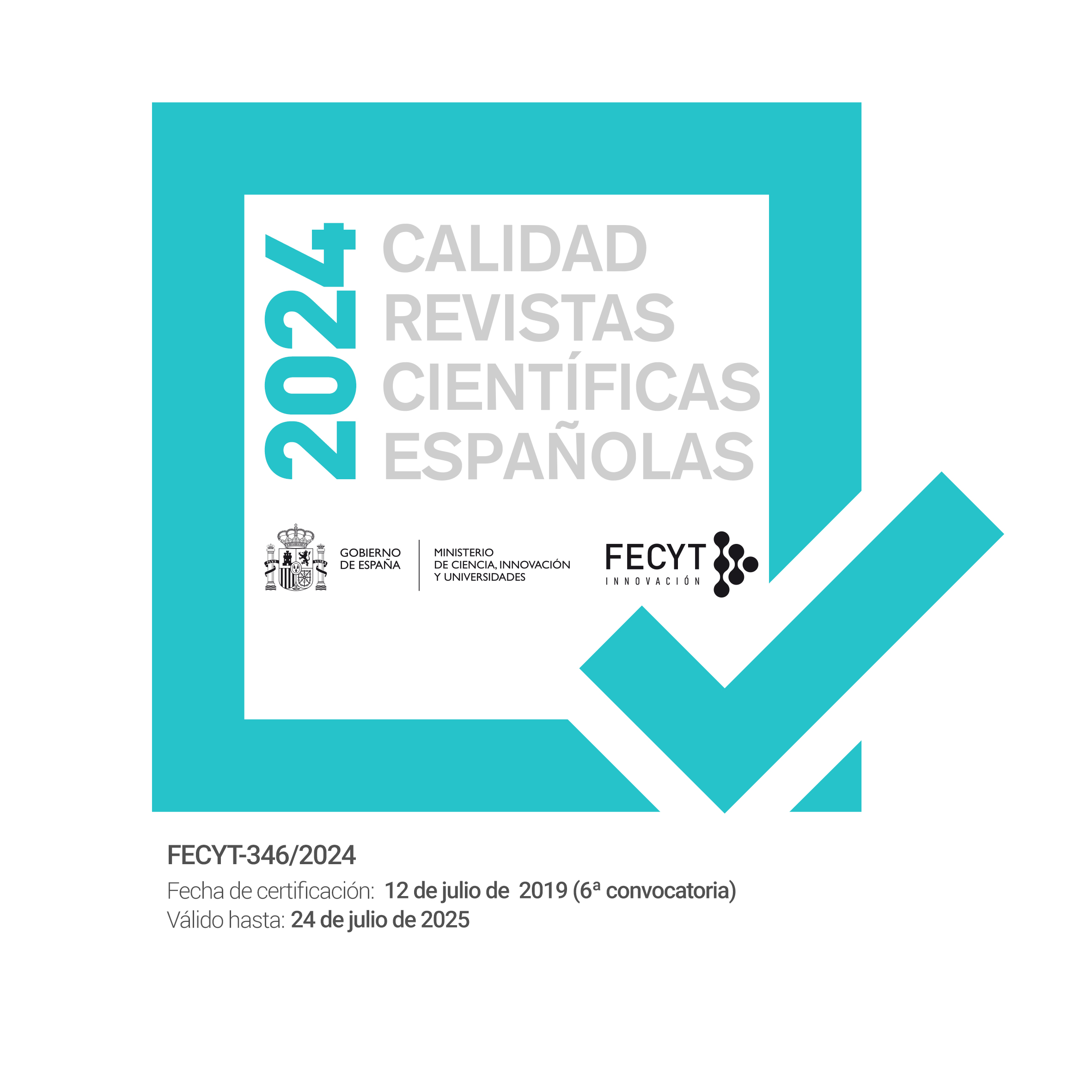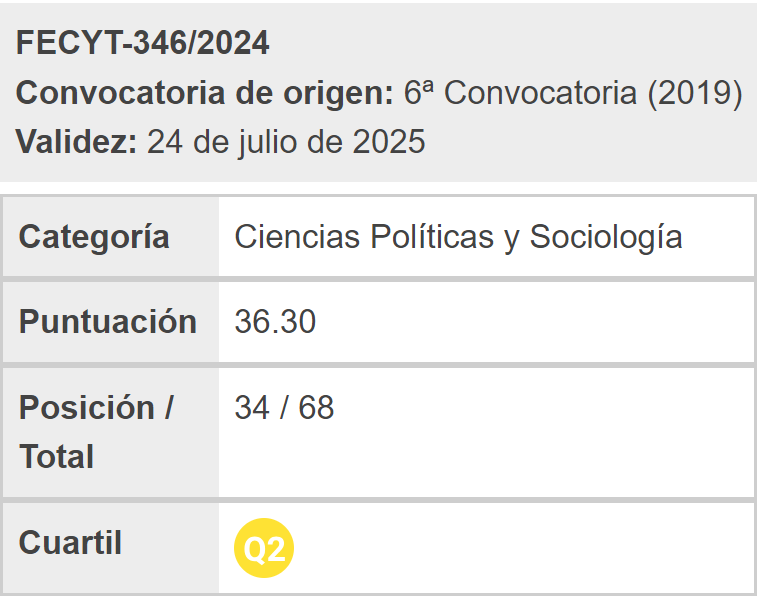El papel de las redes sociales digitales en la integración de los jóvenes migrantes marroquíes en España
Keywords:
Migration, digital social networks, youth, Morocco, integrationAbstract
This study analyzes the use of digital social networks among migrant youth of Moroccan origin currently residing in Spain. A qualitative methodology has been applied that combines non-systematized participant observation and fourteen in-depth interviews with young people who migrated to Spain from Morocco as minors. We try to analyze two questions. The first, discover the influence that digital platforms have had in the integration process of this migrant youth in the host society. The literature on this matter is totally divided between those who think that new technologies favor the integration of the migrant population, and, on the other hand, those who believe that it is harmful to them. The second issue lies in analyzing how digital social networks have affected the communication that migrant youth have with their loved ones who remain at their origin. In this case, there is a greater consensus in the literature that advocates an enormous facilitation of transnational communications. We found as a result that migrant youth have appropriated digital platforms and have learned to use them in their integration processes, as well as in their daily communications. Digital social networks have not only improved transnational family relationships, generating well-being in both migrants and their families, but they have also facilitated the communication of migrant youth with the new actors that are appearing in their contexts in the host society.
Downloads
References
Aretxabala, María Esther y Xabier Riezu (2012). Beyond boundaries: Reflections on the impact of ICTs usage for social capital of international migrants. International Economics Letters, 1, 5-14.
Bacigalupe, Gonzalo y María Cámara (2012). Transnational families and social technologies: Reassessing immigration psychology. Journal of Ethnic and Migration Studies, 38(9), 1425-1438. https://doi.org/10.1080/1369183X.2012.698211
Benítez Eyzaguirre, Lucía (2013). La recepción transnacional de la televisión en los proyectos migratorios. Un estudio de campo en poblaciones marroquíes. Agencia Pública Empresarial de la Radio Televisión de Andalucía (RTVA).
Brekke, Idunn y Arne Mastekaasa (2008). Highly educated immigrants in the Norwegian labour market: Permanent disadvantage? Work, employment and society, 22(3), 507-526. https://doi.org/10.1177/0950017008093483
Cerda, Julia (2014). Las familias transnacionales. Revista Espacios Transnacionales, 2, 78-88.
Codagnone, Cristiano y Stefano Kluzer (2011). ICT for the Social and Economic Integration of Migrants into Europe. Publication Office of the European Union.
Delgado Ruiz, Manuel (1998). Diversitat i integració. Lògica i dinàmica de les identitats a Catalunya. Empúries.
Denzin, Norman K. (2001). La entrevista reflexiva y una ciencia social performativa. Qualitative research, 1(1), 23-46. https://doi.org/10.1177/146879410100100102
Diminescu, Dana (2008). The connected migrant: An epistemological manifesto. Social science information, 47(4), 565-579. https://doi.org/10.1177/0539018408096447
Elias, Nelly y Dafna Lemish (2009). Spinning the web of identity: The roles of the internet in the lives of immigrant adolescents. New Media y Society, 11(4), 533-551. https://doi.org/10.1177/1461444809102959
Ellison, Nicole. B.; Charles Steinfield y Cliff Lampe (2007). The benefits of Facebook "friends:" Social capital and college students' use of online social network sites. Journal of computer-mediated communication, 12(4), 1143-1168. https://doi.org/10.-1111/j.1083-6101.2007.00367.x
Enríquez Rosas, María del Rocío (2000). Redes sociales y pobreza: Mitos y realidades. Revista de Estudios de Género - La Ventana, 1(11), 36-72.
Escarbajal, Andrés; Rebeca Martínez Fuentes y Carmen M. Caballero (2023). Estudio sobre la Situación y Percepción de Menores Extranjeros no Acompañados (MENAS) en la Región de Murcia (España): Factores Clave para su Inclusión. Revista Iberoamericana De Evaluación Educativa, 16(1), 47–65. https://doi.org/10.15366/riee-2023.16.1.003
García Galera, María del Carmen, y Mercedes del Hoyo Hurtado (2013). Redes sociales, un medio para la movilización juvenil. Zer, 18(34), 11-125.
Gómez-Escalonilla, Gloria; Yolanda Martínez Suárez y Marina Santín (2014). Identidades on-line y juventud migrante: análisis cualitativo de los criterios de elección de las imágenes auto- representativas. Revista de la Asociación Española de Investigación de la Comunicación, 1(1), 96-103. https://doi.org/10.24137/raeic.1.1.10
Gual, Andreu Mir (2022). Identidad, inmigración y adolescencia. Migraciones. Publicación del Instituto Universitario de Estudios sobre Migraciones, 54, 1-20. https://doi.org/10.14422/mig.i54y2022.005
Guasch, Oscar (1997). Observación participante. CIS.
Guevara-Perea, María y José Candón-Mena (2024). La influencia de las redes en los imaginarios sobre España de los menores migrantes marroquíes. Index. Comunicación, 14(1), 107–130. https://doi.org/10.62008/ixc/14/01Lainfl
Hernández Fernández, Coral; José Antonio Alcoceba Hernando y María Cadilla Baz. (2014). La percepción del riesgo en las redes sociales entre la juventud inmigrada en España. Revista de la Asociación Española de Investigación de la Comunicación, 1(1), 1-11.
Holstein, James A., y Jaber F. Gubrium (1995). The active interview. Sage. https://doi.org/10.4135/9781412986120
Instituto Nacional de Estadística (2023). Encuesta sobre Equipamiento y Uso de Tecnologías de Información y Comunicación en los Hogares.
Gil Juárez, Adriana; Joel F. Samuel-Lajeunesse; Horacio EspinosaZepeda y M. Teresa Ramírez Corvera (2007). Internet como un artefacto relacional: Jóvenes, migraciones y TIC. En Psicología Social: Un Encuentro de Perspectivas (pp. 492-497). Asociación de profesionales de la Psicología Social.
Kahne, Joseph; Ellen Middaugh; Namjin Lee y Jessica T. Feezell (2012). Youth online activity and exposure to diverse perspectives. New media & society, 14(3), 492-512. https://doi.org/10.1177/1461444811420271
Komito, Lee (2011). Social media and migration: Virtual community 2.0. Journal of the American Society for Information Science and Technology, 62(6), 1075-1086. https://doi.org/10.1002/asi.21517
Lubbers, Miranda J. y José Luis Molina (2013). El proceso de la reconstrucción de la red personal de los inmigrantes: una descripción longitudinal. Empiria: revista de metodología de ciencias sociales, 26, 63-88. https://doi.org/10.5944/empiria.26.2013-7153
Lubbers, Miranda J.; José Luis Molina; Jürgen Lerner; Ulrik Brandes; Javier Ávila y Mc Christopher Carty (2010). Longitudinal analysis of personal networks. The case of Argentinean migrants in Spain. Social networks, 32(1), 91-104. https://doi.org/10.1016/j.socnet.2009.05.001
Lugo Sánchez, Luis Josué (2020). Esferas públicas digitales y su relación con la opinión pública. Move.net. Investigación acción participante en el caso de #CaravanaMigrante. Grupo Interdisciplinario de Estudios en Comunicación, Política y Cambio Social de la Universidad de Sevilla (COMPOLÍTICAS).
McGregor, Elaine y Melissa Siegel (2013). Social Media and Migration Research. MERIT Working Papers (N.o 2013-068; MERIT Working Papers). United Nations University - Maastricht Economic and Social Research Institute on Innovation and Technology (MERIT).
Melella, Cecilia E. y Gimena Perret (2016). El uso de Internet en contextos migratorios: Una aproximación a su estudio. Enl@ce. Revista Venezolana de Información, Tecnología y Conocimiento, 13(2), 71-92.
Millán-Franco, Mario; Luis Gómez-Jacinto; Isabel Hombrados-Mendieta y Alba García-Cid (2019). Las redes de apoyo social online y offline en los inmigrantes de Málaga (España). Migraciones, 47, 119-149. https://doi.org/10.14422/mig.i47y2019.005
Monge Benito, Sergio y Elena Olábarri Fernández (2011). Autoexpresión y privacidad de los universitarios en las redes sociales: Los estudiantes de la Universidad del País Vasco como caso de estudio. Doxa comunicación. https://doi.org/10.31921/doxacom.n13a4
Oroza Busutil, Rebeca y Yoannis Puente Márquez (2017). Migración y comunicación: Su relación en el actual mundo globalizado. Revista Novedades en Población, 13(25), 10-16.
Orús, Abigail (2022). Uso de los medios de comunicación en España. Statista (febrero).
Portes, Alejandro (1997). Globalization from below: The rise of transnational communities. Citeseer.
Prensky, Marc (2001). Digital natives, digital immigrants part 2: Do they really think differently? On the horizon, 9(6). https://doi.org/10.1108/10748120110424843
Puyo, Álvaro; Álvaro Bravo; Eva Ortigosa; Ana Rojas; Karina Barandiarán y Ane Maroño (2021). La acogida de menores migrantes en España. Marco normativo, sistema administrativo y formatos de acogida. Por Causa.
Ramírez García, Telésforo (2014). Mudando el hogar al norte: Trayectorias de integración de los inmigrantes mexicanos en Los Ángeles. Migraciones internacionales, 7(3), 261-265.
UNData (2023). Internet usage Percentage of individuals per country. Naciones Unidas. https://data.un.org/_Docs/SYB/PDFs/SYB66_314_202310_Internet%20Usage.pdf
Valkenburg, Patti M. y Jochen Peter (2007). Online communication and adolescent well-being: Testing the stimulation versus the displacement hypothesis. Journal of Computer-Mediated Communication, 12(4), 1169-1182. https://doi.org/10.1111/j.1083-6101.2007.00368.x
We Are Social y Kepios (2022). Digital 2022: DataReportal - Global Digital Insights. https://wearesocial.com/es/blog/2022/01/digital-2022/
Downloads
Published
How to Cite
Issue
Section
License
Copyright (c) 2024 Encrucijadas. Revista Crítica de Ciencias Sociales

This work is licensed under a Creative Commons Attribution-NonCommercial-NoDerivatives 4.0 International License.
Los autores/as conservan los derechos de autor y ceden a la revista el derecho de la primera publicación, con el trabajo registrado con la licencia de atribución de Creative Commons Reconocimiento-NoComercial (CC-BY 4.0), que permite a terceros utilizar lo publicado siempre que mencionen la autoría del trabajo y a la primera publicación en esta revista. Encrucijadas permite y se anima a todas las personas autoras a depositar la versión final publicada en repositorios institucionales o temáticos de acceso abierto, cumpliendo en caso necesario los términos establecidos por la entidad financiadora de la investigación.




